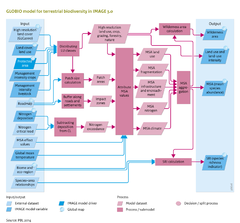Terrestrial biodiversity/Policy issues: Difference between revisions
Jump to navigation
Jump to search
Oostenrijr (talk | contribs) m (Text replace - "(Figure" to "(the figure") |
Oostenrijr (talk | contribs) No edit summary |
||
| Line 1: | Line 1: | ||
{{ComponentPolicyIssueTemplate | {{ComponentPolicyIssueTemplate | ||
|Reference=PBL, 2012; | |Reference=PBL, 2012; | ||
|Description=The GLOBIO model is used regularly to evaluate biodiversity impacts under baseline scenarios. Although the biodiversity decline depends on scenario assumptions, these studies all project decline in coming decades at a similar rate as in the previous decades. The main drivers of biodiversity loss are land-use change, infrastructure expansion and, increasingly, climate change (the figure below). | |Description=The GLOBIO model is used regularly to evaluate biodiversity impacts under baseline scenarios. Although the biodiversity decline depends on scenario assumptions, these studies all project decline in coming decades at a similar rate as in the previous decades. The main drivers of biodiversity loss are land-use change, infrastructure expansion and, increasingly, climate change (the figure below). | ||
|Example=Biodiversity loss is caused by a wide range of activities in various sectors, and policy interventions in major sectors could prevent or reduce biodiversity loss. The most often suggested option is protection of specific nature areas (reserves) to prevent further habitat loss for selected ecosystems. In addition, land pressure could be reduced, for example, by intensification of production, a shift in the human diet to fewer animal products, and waste reduction. The impact of climate change on biodiversity reduces with effective mitigation policies in place. Increase in sustainable forests may also reduce biodiversity loss in the long term. | |Example=Biodiversity loss is caused by a wide range of activities in various sectors, and policy interventions in major sectors could prevent or reduce biodiversity loss. The most often suggested option is protection of specific nature areas (reserves) to prevent further habitat loss for selected ecosystems. In addition, land pressure could be reduced, for example, by intensification of production, a shift in the human diet to fewer animal products, and waste reduction. The impact of climate change on biodiversity reduces with effective mitigation policies in place. Increase in sustainable forests may also reduce biodiversity loss in the long term. | ||
Revision as of 14:46, 1 July 2014
Parts of Terrestrial biodiversity/Policy issues
| Component is implemented in: |
|
| Projects/Applications |
| Key publications |
| References |
